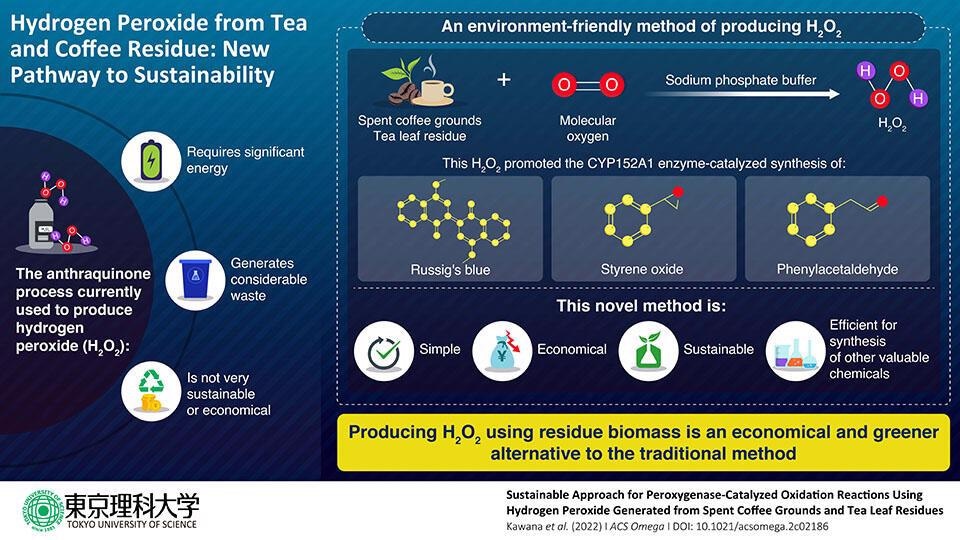H2O2 (hydrogen peroxide) is an essential substance with a wide range of uses. However, the existing method for producing H2O2 is costly and produces a significant amount of waste, making it unsustainable.
 Sustainable Approach for Peroxygenase-Catalyzed Oxidation Reactions Using Hydrogen Peroxide Generated from Spent Coffee Grounds and Tea Leaf Residues. Image Credit: Kawana, et al.
Sustainable Approach for Peroxygenase-Catalyzed Oxidation Reactions Using Hydrogen Peroxide Generated from Spent Coffee Grounds and Tea Leaf Residues. Image Credit: Kawana, et al.
A group of Japanese researchers created H2O2 from waste coffee grounds and tea leaves and then illustrated its industrial application. Their innovative approach proved to be simple, cost-effective, and most notably, sustainable.
Coffee and tea are two of the most widely consumed liquids on the planet. Large volumes of coffee grounds and tea leaves are produced as a result of the widespread use of these beverages, which are often dumped as garbage.
However, these underutilized biomass resources have the potential to create a variety of important compounds. Polyphenols are a kind of chemical found in tea and coffee that can create hydrogen peroxide (H2O2).
H2O2 has a high commercial value since it is used in the oxidation of a variety of substances. The oxidation process is usually conducted by the enzyme P450 peroxygenase, although it cannot happen without H2O2.
Many important compounds are made via these oxidation processes. H2O2 is presently manufactured using an unsustainable technology known as the anthraquinone process, which is not only energy-intensive but also wasteful, underscoring the need for a greener, more ecologically friendly alternative.
Other ways of producing H2O2 that employ enzymes or light are more costly since they require catalysts and extra chemicals.
With these concerns in mind, a group of Japanese scientists led by Associate Professor Toshiki Furuya and Mr. Hideaki Kawana of Tokyo University of Science, as well as Dr. Yuki Honda of Nara Women’s University, have devised a new method of producing H2O2.
Their product is made from the remains of brewed tea and coffee, which are referred to as spent coffee grounds (SCG) or tea leaf residue (TLR).
Given their polyphenol content, we predicted that SCG and TLR could be used to produce hydrogen peroxide.
Toshiki Furuya, Associate Professor, Tokyo University of Science
Their study, which was published in ACS Omega on June 1st, 2022, outlines their effective generation of H2O2 from these underused biomass resources, proving their prognosis.
Adding coffee grinds and tea leaves to a sodium phosphate buffer, then incubating the solution while shaking it, was the team’s technique of manufacture. SCG and TLR reacted with molecular oxygen to create H2O2 in the presence of the buffer.
The researchers also looked at the possibility of utilizing this H2O2 to make other industrially important compounds. The production of Russig’s blue was made easier thanks to the freshly synthesized H2O2.
Furthermore, in the presence of peroxygenase (an enzyme that catalyzes an oxidation reaction using H2O2), TLR- and SCG-derived H2O2 was free to react with a molecule called styrene to produce styrene oxide (which has several applications in medicine) and phenylacetaldehyde (another useful compound).
In comparison to the classic anthraquinone procedure, the team’s innovative strategy of combining SCG and TLR to manufacture H2O2 proved to be easy, cost-effective, and ecologically benign.
Dr. Furuya outlined, “Our method can be used to produce hydrogen peroxide from materials that would otherwise have been discarded. This could further result in new ways to synthesize industrial chemicals like styrene oxide, opening up new applications for these unused biomass resources.”
As a result, the discoveries open up a new path to sustainable H2O2 generation from tea and coffee waste, the most unexpected sources.
Journal Reference:
Kawana, H., et al. (2022) Sustainable Approach for Peroxygenase-Catalyzed Oxidation Reactions Using Hydrogen Peroxide Generated from Spent Coffee Grounds and Tea Leaf Residues. ACS Omega. doi:10.1021/acsomega.2c02186.